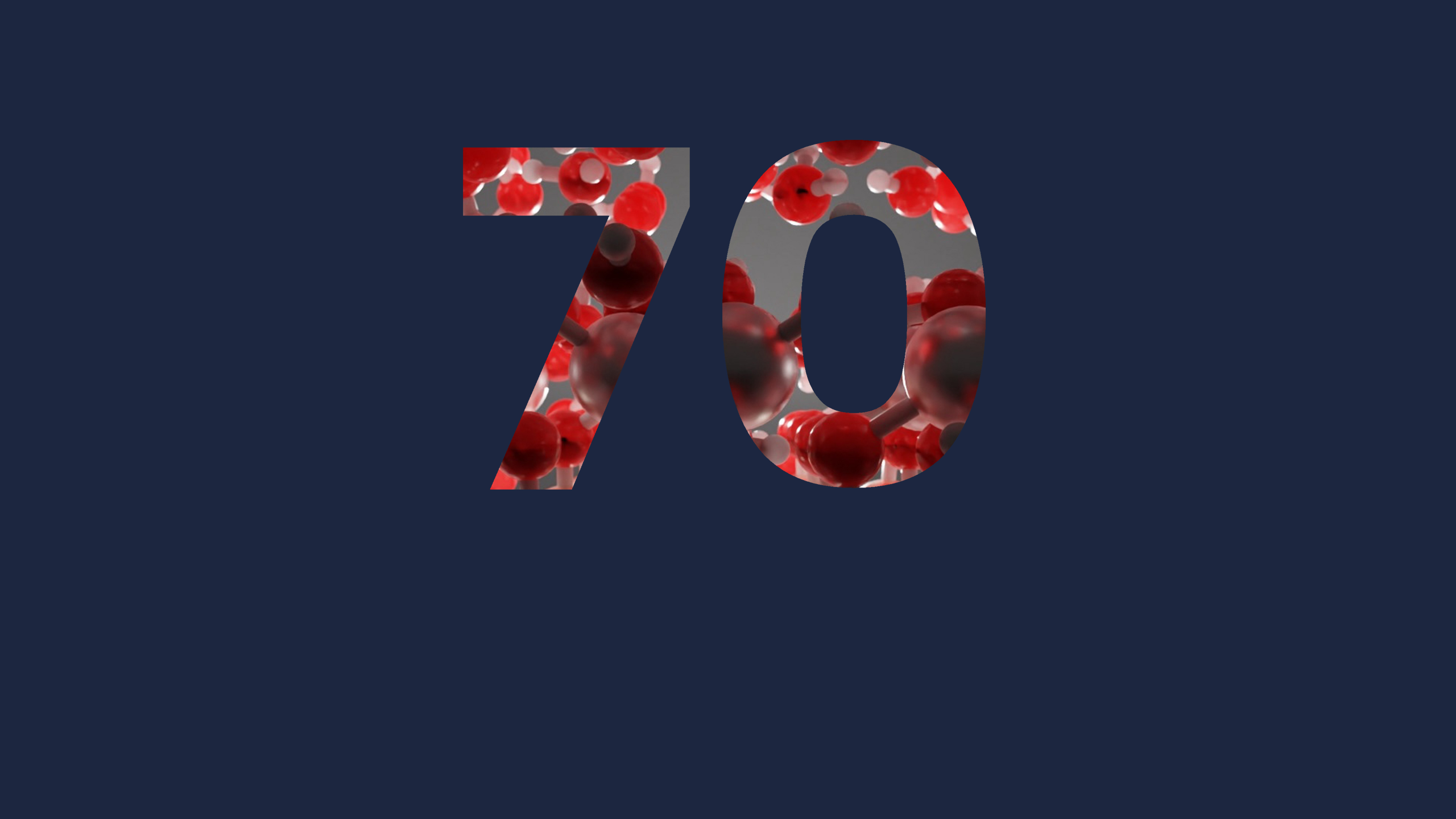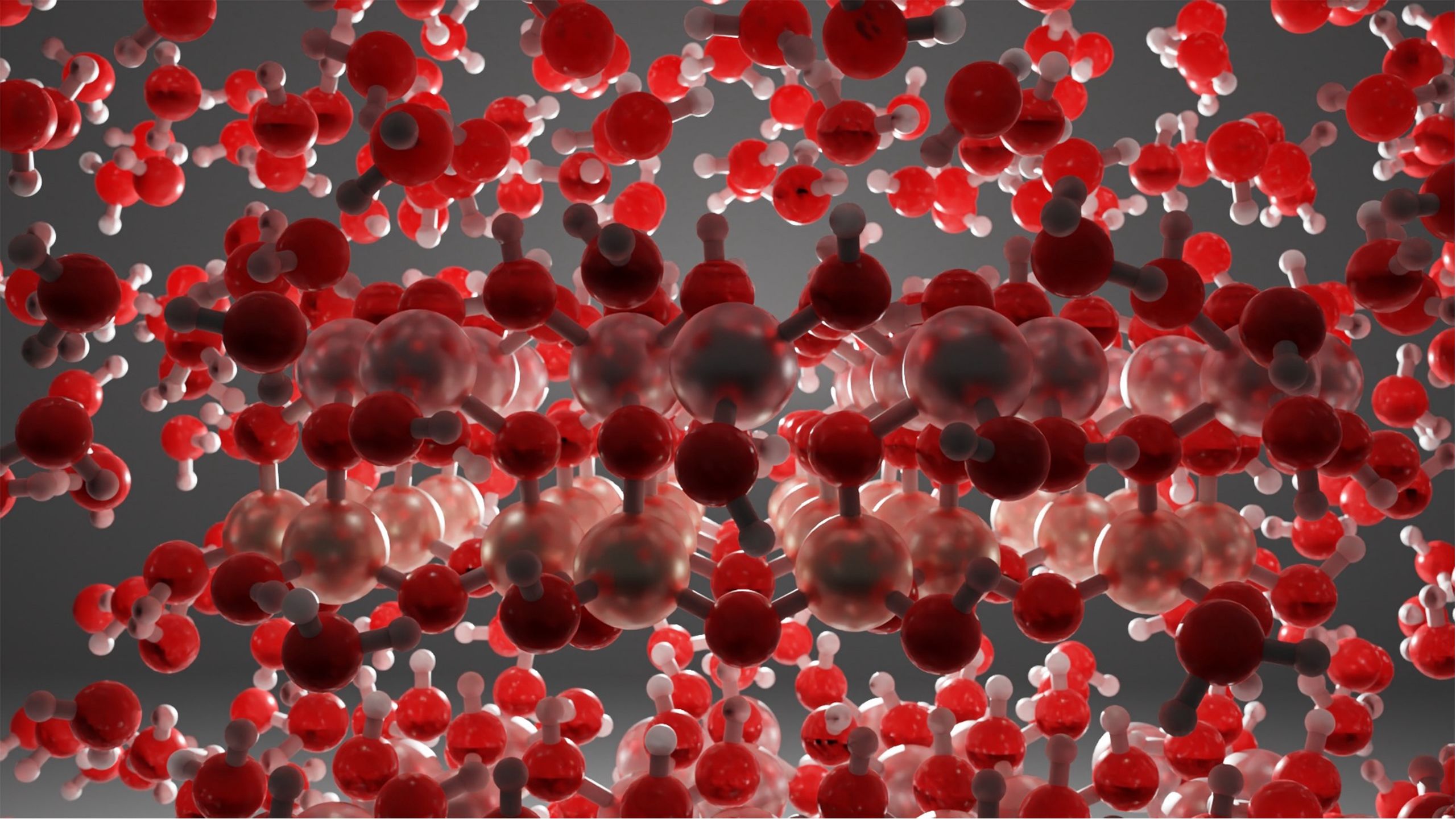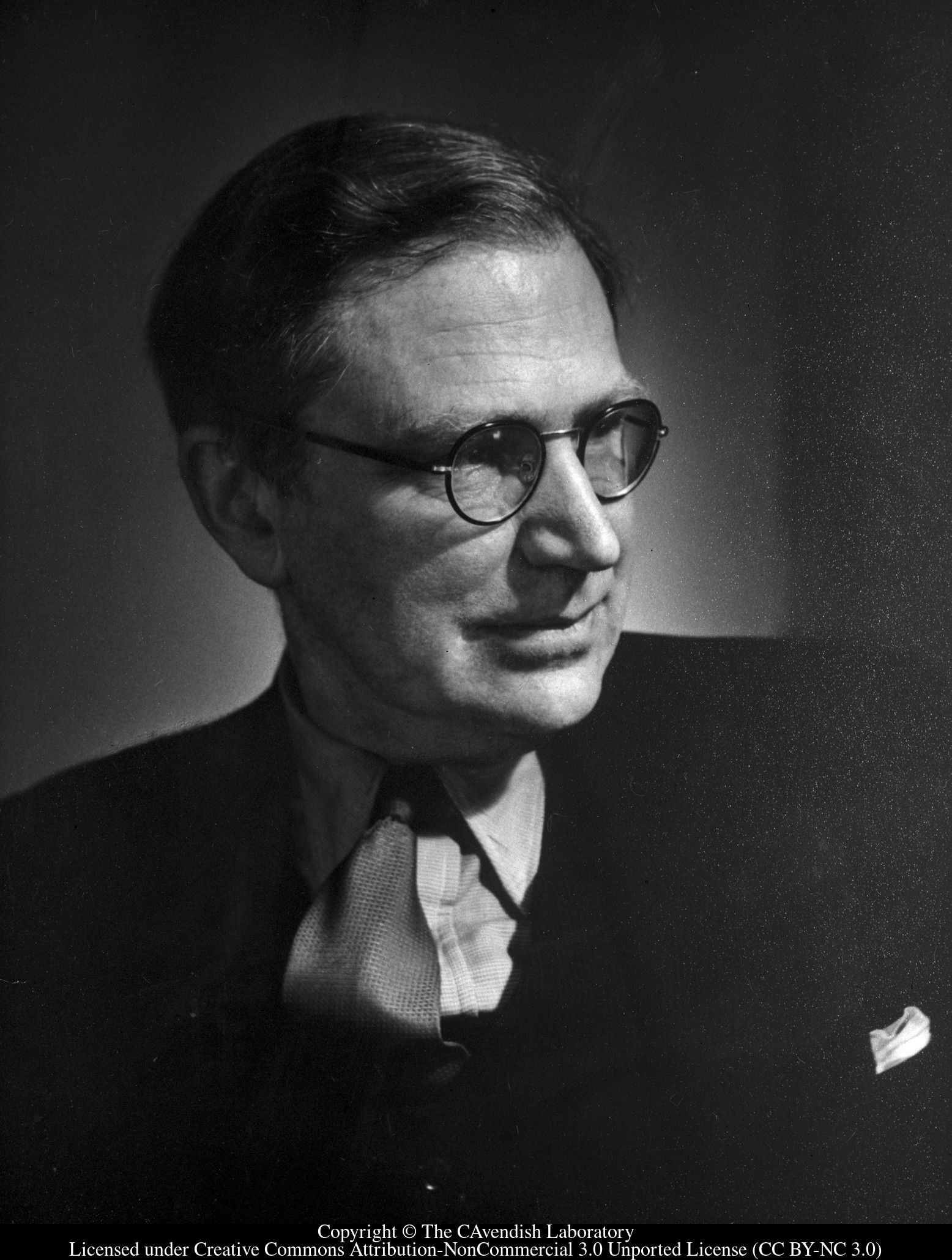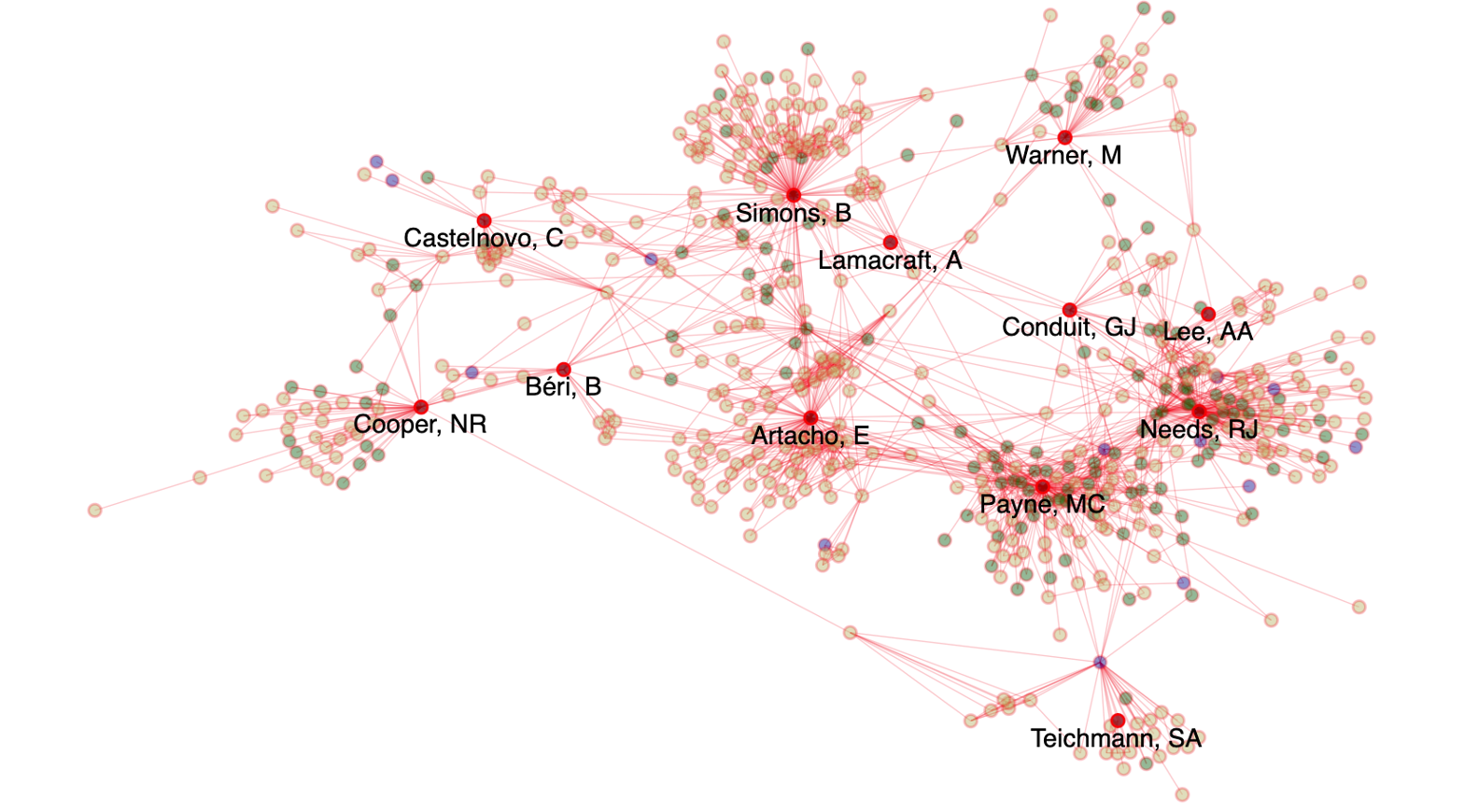Seventy years of the Theory of Condensed Matter Group

Members of the Theory of Condensed Matter Group reflect on
the history of one of the Cavendish Laboratory’s longest standing research groups, whose pioneering work continues to push back the frontiers of our understanding of matter.

Image above: Molecular modelling illustration. © Samuel Brookes/Christoph Schran
Maintaining a research group for 70 years is a significant accomplishment in itself, but the Theory of Condensed Matter (TCM) group’s long and consistent track record of world-leading, seminal research is far more significant. This has been achieved by constantly innovating and moving to new research challenges, and by allowing our exceptionally bright young researchers the opportunity to develop their own research and to ensure that they receive recognition for doing so.
Over the years, six Nobel prize winners (Mott, Anderson, Josephson, Thouless, Haldane and Jumper) and four Europhysics Prize winners (Khmelnitskii, Rice, Warner and Castelnovo) have come through TCM, alongside many other award winners. We are immensely proud of the successes of all the members of TCM - not just the world-leading academic researchers but also those who have created start- ups or gone on to high level positions in industry, finance and elsewhere. There are too many to list in a single article so we will mention just some of the notable events from the history of the group.
Image: The TCM Group at its 50th birthday celebration.
Condensed matter theory seeks to develop mathematical models and numerical approaches to understand and predict the behaviour of many-particle systems, where collective phenomena emerge that can differ markedly from the properties of their constituents. For instance, the hydrodynamics of water is not revealed in the dynamics of a single water molecule. “More is different” as Philip Anderson put it.
Image above: The TCM Group at its 50th birthday celebration.
Over the years, six Nobel prize winners (Mott, Anderson, Josephson, Thouless, Haldane and Jumper) and four Europhysics Prize winners (Khmelnitskii, Rice, Warner and Castelnovo) have come through TCM, alongside many other award winners. We are immensely proud of the successes of all the members of TCM - not just the world-leading academic researchers but also those who have created start- ups or gone on to high level positions in industry, finance and elsewhere. There are too many to list in a single article so we will mention just some of the notable events from the history of the group.
Condensed matter theory seeks to develop mathematical models and numerical approaches to understand and predict the behaviour of many-particle systems, where collective phenomena emerge that can differ markedly from the properties of their constituents. For instance, the hydrodynamics of water is not revealed in the dynamics of a single water molecule. “More is different” as Philip Anderson put it.
Image: Nevill Mott.
The origins of TCM can be traced back to 1st October 1954 when Nevill Mott came to Cambridge as the new Cavendish Professor of Experimental Physics – which was somewhat ironic as Mott was a theoretician. TCM was originally called the Solid State Theory Group but in 1972 changed its name to the Theory of Condensed Matter (allegedly Phil Anderson’s suggestion), reflecting its broader range of research and thereby coining the term ‘condensed matter’.
Mott’s approach to research was to talk to experimentalists and formulate interesting questions for theoretical research. Mott brought John Ziman from Oxford with him as a young lecturer, who quickly gathered a small group of research
students around him, including Lu Sham, who is now well known for his seminal work on density functional theory with Walter Kohn. Other famed PhD students in TCM include Maurice Rice, Neil Ashcroft and Duncan Haldane. Ziman initiated the concept of formal graduate lectures as a central part of graduate education, which continue to this day.
Also in 1954, Volker Heine arrived in Cambridge as a PhD student from New Zealand, after a one-month boat journey, hoping to be supervised by Mott. However, their first meeting ended with Mott instructing him to “go down to the Low Temperature Physics laboratory and see if you can make yourself useful!”, leading to Volker’s move into computational physics and his battles with the EDSAC 1 computer. He pioneered a research field that nowadays is often referred to as ‘electronic structure’ which measures its annual publications in kilopapers!
Mott's presence provided a focus for theoretical physicists and TCM received a stream of distinguished academic visitors. In TCM’s early years, these included Hans Bethe, Phil Anderson, Marvin Cohen, Philippe Nozières. Bethe
gave the first lecture course in Cambridge on many-body theory. Subsequently, Mott persuaded Anderson to split his time equally between Bell Laboratories and Cambridge, an arrangement that continued until the mid-1970s.
The origins of TCM can be traced back to 1st October 1954 when Nevill Mott came to Cambridge as the new Cavendish Professor of Experimental Physics – which was somewhat ironic as Mott was a theoretician. TCM was originally called the Solid State Theory Group but in 1972 changed its name to the Theory of Condensed Matter (allegedly Phil Anderson’s suggestion), reflecting its broader range of research and thereby coining the term ‘condensed matter’.
Mott’s approach to research was to talk to experimentalists and formulate interesting questions for theoretical research. Mott brought John Ziman from Oxford with him as a young lecturer, who quickly gathered a small group of research
students around him, including Lu Sham, who is now well known for his seminal work on density functional theory with Walter Kohn. Other famed PhD students in TCM include Maurice Rice, Neil Ashcroft and Duncan Haldane. Ziman initiated the concept of formal graduate lectures as a central part of graduate education, which continue to this day.
Also in 1954, Volker Heine arrived in Cambridge as a PhD student from New Zealand, after a one-month boat journey, hoping to be supervised by Mott. However, their first meeting ended with Mott instructing him to “go down to the Low Temperature Physics laboratory and see if you can make yourself useful!”, leading to Volker’s move into computational physics and his battles with the EDSAC 1 computer. He pioneered a research field that nowadays is often referred to as ‘electronic structure’ which measures its annual publications in kilopapers!
Mott's presence provided a focus for theoretical physicists and TCM received a stream of distinguished academic visitors. In TCM’s early years, these included Hans Bethe, Phil Anderson, Marvin Cohen, Philippe Nozières. Bethe
gave the first lecture course in Cambridge on many-body theory. Subsequently, Mott persuaded Anderson to split his time equally between Bell Laboratories and Cambridge, an arrangement that continued until the mid-1970s.
Image: Nevill Mott
In the early 1960s, Brian Josephson started his PhD under the supervision of Brian Pippard. Extraordinarily talented at a young age, Josephson published a notable paper on the Mössbauer effect as an undergraduate student but is best known for his graduate student work on the eponymous effect, for which he received the Nobel prize a decade later.
The role of topology in condensed matter systems is currently a significant area of research. David Thouless, the instigator of this field, was in TCM in the 1960s and again briefly in the 1980s. Duncan Haldane was a member of the group in the 1970s. They, with Michael Kosterlitz who was a Cambridge undergraduate, were jointly awarded the 2016 Nobel prize for ‘theoretical discoveries of topological phase transitions and topological phases of matter’.
TCM has continued to innovate in this field, for example Nigel Cooper’s work making connections to cold atomic gases, Benjamin Béri to quantum information, and Anton Souslov to active matter. The recent significant growth in this field means that many PhD students, postdocs and research fellows in TCM currently work on topological problems. Two of them, Robert-Jan Slager and Nur Unal have just moved to permanent academic positions at leading UK universities.
Sam Edwards joined TCM in 1972 and eventually led a large group working primarily on understanding the behaviour of polymers, soft matter and related systems. In 1984, Sam was appointed Cavendish Professor, by which time the reference to ‘experimental physics’ had been dropped. This area was extremely active in the 1980s with Robin Ball, Mark Warner and Mike Cates holding lectureships. Sam was noted for his ability to attract industrial funding – though this did, at times, cause consternation elsewhere in the University.
Electronic structure came of age in the 1990s. Density functional theory and the development of computer codes allowed predictive calculations on systems containing hundreds of atoms and the ability to answer questions like ‘what would happen if this atom were not allowed to move’.
This development marked the end of the ‘create whatever model you like’ approach to explain experimental results - as models could, finally, be rigorously tested. Volker inspired the electronic structure community in the UK and Europe and fostered a spirit of collaboration that was critical to the field’s success. TCM has had enormous strength in depth in this field for many years through Richard Needs, Mike Payne, Emilio Artacho and Christoph Schran.
Ben Simons started his PhD in TCM in 1987 and was appointed to a lectureship in 1995. His early research included work on high temperature superconductivity and quantum phase transitions. His research subsequently moved into biological physics and he was appointed to the Herchel Smith Chair in Physics in 2011.
Much of TCM’s pioneering research has become mainstream, in physics and in other disciplines. Just taking a few examples within Cambridge: soft active matter is now a significant research activity in the Department of Applied Mathematics and Theoretical Physics (DAMTP) where Mike Cates holds the Lucasian Chair; electronic structure is
a major activity in Chemistry, Engineering and Materials, where former TCM member Chris Pickard holds the Sir Alan Cottrell Chair; and, in addition to his many links to biology departments and institutions, Ben Simons also holds a Royal Society professorship in DAMTP.
Image: A graph showing papers published by members of TCM, as recorded by the University's Symplectic database. Each circle represents an author, and each line denotes that the two authors it joins have co-authored one or more papers.
The research activities in TCM have grown and diversified throughout the years, with new members joining to work on low dimensional and disordered systems, machine learning and far from equilibrium phenomena (Austen Lamacraft); frustrated magnetism, quantum spin liquids and quantum computing, and glassy phenomena (Claudio Castelnovo); topological phenomena and Majorana states, quantum circuits and quantum information (Benjamin Béri); active solids, viscoelasticity, and topological states in mechanics and fibre optics (Anton Souslov).
Image: A graph showing papers published by members of TCM, as recorded by the University's Symplectic database. Each circle represents an author, and each line denotes that the two authors it joins have co-authored one or more papers.
Much of TCM’s pioneering research has become mainstream, in physics and in other disciplines. Just taking a few examples within Cambridge: soft active matter is now a significant research activity in the Department of Applied Mathematics and Theoretical Physics (DAMTP) where Mike Cates holds the Lucasian Chair; electronic structure is
a major activity in Chemistry, Engineering and Materials, where former TCM member Chris Pickard holds the Sir Alan Cottrell Chair; and, in addition to his many links to biology departments and institutions, Ben Simons also holds a Royal Society professorship in DAMTP.
The research activities in TCM have grown and diversified throughout the years, with new members joining to work on low dimensional and disordered systems, machine learning and far from equilibrium phenomena (Austen Lamacraft); frustrated magnetism, quantum spin liquids and quantum computing, and glassy phenomena (Claudio Castelnovo); topological phenomena and Majorana states, quantum circuits and quantum information (Benjamin Béri); active solids, viscoelasticity, and topological states in mechanics and fibre optics (Anton Souslov).
The group continues to interact closely with many experimental groups, drawing inspiration from experimental developments to make further advances in theoretical physics. The rapid developments across the growing breadth of TCM research promise future success, as attested by the Nobel Prize in Chemistry 2024 recently awarded to our alumnus John Jumper.
We will be celebrating TCM’s 70th Birthday at the Cavendish Laboratory (Ray Dolby Centre) on the 25th July 2025.
Further information will be provided in forthcoming CavMags and on the TCM web pages tcm.phy.cam.ac.uk/events/tcm70
Email TCM70@tcm.phy.cam.ac.uk to be added to the mailing list for the event.


